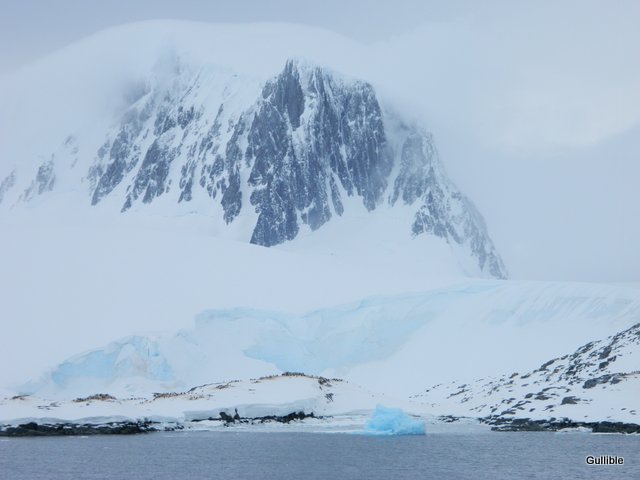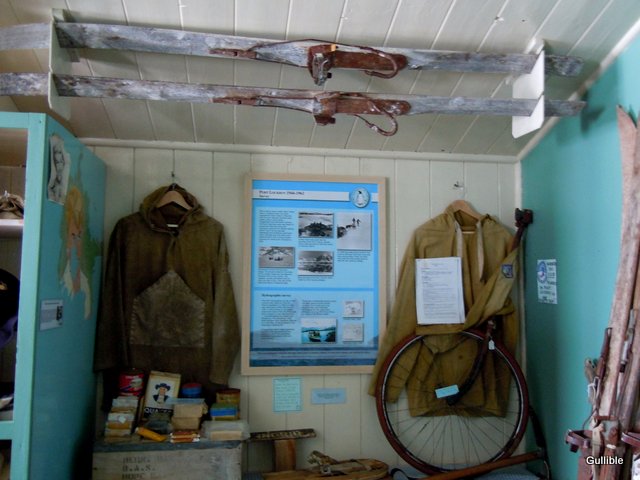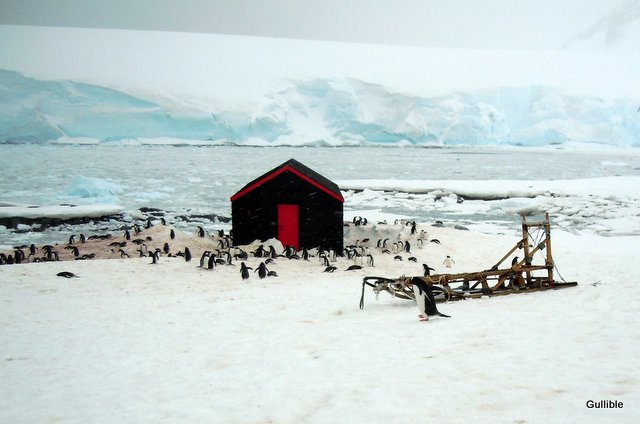Soon after launching from Elephant Island, the James Caird encounters pack ice. The men push and row their way through the chaos
of bergs and pans of ice until they finally break free into open water that
evening.
Ernest Shackleton realizes that this rare day of sunshine
was providential, and that a further delay would see the pack ice so dense they
could not have escaped it. Now, though
free of the ice, they are fully exposed to the dangers of Drake Passage and the
Scotia Sea, the most stormy and treacherous water on the globe.
Even on this relatively easy day, the men are soon soaked by
breaking waves. They are wearing woolen
underwear, cloth trousers, and woolen sweaters, gloves, socks, and
balaclavas. Over this they have Burberry
overalls that are windproof, but not waterproof.
Meals are eaten under the covered deck, which has so little
room that they are bent over double when they attempt to sit on the cold ballast
rock. The space they call “the salon” is
only five by seven feet. To reach their
sleeping bags in the covered bow, they have to crawl over the rocks and duck
under a low thwart, then attempt to sleep, knowing how impossible it would be
to escape in an emergency.
Waves crash over the ship and soak the men every few
minutes. Bailing and operating the pump—a
particularly onerous chore requiring a back-breaking position and holding the
pump against the bilge with bare hands—are a constant necessity.
The temperature is so cold that ice forms, threatening to
sink the James Caird. Even more dangerous is chipping 15 inches of
ice off the boat, sails, and canvas cover. Vincent almost falls into the sea while
stretched out on the slippery deck canvas and saves himself by grabbing a mast
as he slides past.
Six days into the journey, Shackleton notices a line of
light behind him during his watch and thinks the horrendous gale that has
plagued them is breaking up. Then he
looks again and realizes the “light” is the crest of a wave of massive
proportions. “For God’s sake, hold
on! It’s got us,” he screams to the men.
They think they are goners. Unbelievably, the James Caird rises through the inundation
and the men bail water for their lives. Finally, the James Caird feels like she is afloat rather than wallowing to her doom.
There are few clear skies that allow Worsley, the navigator,
to take a sighting with his sextant. On
the ninth day he is able to determine they have covered 444 miles, more than
half the distance to South Georgia.
Another gale blows up with heavy seas, and Worsley is unable
to be certain of his sightings. They
decide to aim for the west coast of South Georgia, rather than the east side
where the whaling stations are because it is entirely possible they could miss
the island altogether and be lost in the huge expanse of the southern Atlantic.
On the 8th of May, they see the towering
mountains of South Georgia, but hurricane force winds threaten to smash them
against the cliffs of the island.
So close, so close, yet the storm has the men fighting to
stay afloat. Many think this is the end,
that they will drown in this wretched storm.
They fight all night.
Morning brings little wind but heavy cross seas. Five times the men sail toward the entrance of King Haakon Bay, and five times they are thwarted by the
sea.
Finally, after 17 days in the worst possible dangers and
conditions, the James Caird rides a
swell over a reef and slides into a small cove near the entrance to King Haakon Bay. They had left Elephant Island on April 24. It is now the 10th of May. They have sailed 800 miles in the worst possible conditions.
The men stumble ashore and secure the boat.
The men stumble ashore and secure the boat.
| A depiction of the James Caird landing at South Georgia. |
A small waterfall is nearby and the men fall to their knees
and drink—the first fresh water they have had in several days.
For now, they are safe, though half-dead with
exhaustion. Help is on the other side of
the island, but high mountains, glaciers, and deep snow are in between. Though the coastline of South Georgia is
known, the maps of the day show the interior as a white void.
(Carolyn Alexander writes in The Endurance: Undoubtedly they were conscious of having
achieved a great journey. They would
later learn that a 500-ton steamer had foundered with all hands in the same
hurricane they had just weathered. But
at the moment they could hardly have known—or cared—that in the carefully
weighed judgment of authorities yet to come, the voyage of the James Caird would be ranked as one of the greatest boat
journeys ever accomplished.)
Note: Though he wanted to be a part of this journey, Frank Hurley stayed behind with the 21 men left at Elephant Island. Thus there are no photographs of this part of the adventure. The depictions above came from http://en.wikipedia.org/wiki/Voyage_of_the_James_Caird
| Shackleton and the five men of the James Caird are now at South Georgia, as shown by the red line. |
***
 We
left the Polish research station of Arctowski on King George Island as
the sun was setting, but just before that, some folks took a refreshing
swim in the Antarctic ocean.
We
left the Polish research station of Arctowski on King George Island as
the sun was setting, but just before that, some folks took a refreshing
swim in the Antarctic ocean.
In the morning we gather around the windows or on the open
decks as we sail towards a British site called Port Lockroy. The seas are calm and the weather is nice, a
perfect day for sight-seeing through the massive icefalls and sheer snow cliffs
of Neumayer Channel.
 |
| This tour boat out of Ushuaia is the only other ship we saw on our trip. |
 |
| Overlooking Port Lockroy are the serrated peaks known as the "Seven Sisters." |
The tell-tale pink lines of penguin colonies come into view
as we near the landing site. There are
penguins everywhere.
 |
| Penguins, penguins, and more penguins. The pink comes from penguin poo. |
 |
| Port Lockroy, surrounded by penguins. |
The Fram drops anchor and the Orange Men go ashore. They cut steps into the side of a wall of
snow and string ropes to assist us in our landing.
 |
| Ice climbing from the boat the Port Lockroy in deep snow. |
The penguins have taken over the station during the winter
when it was not manned. Now, there are
two women here, the first arrivals and they have opened and warmed up the gift
shop. There are eight pallets of freight
onboard the Fram for them, so the gift shop pickings are pretty slim.
 |
| Gentoo penguin and snowy sheathbill. |
 |
| These penguins have decided that underneath the building is their place. |
 |
| The gift shop. |
 |
| The post box. |
But the important thing is the Port Lockroy station is that it is the
only place where postcards can be mailed and franked in Antarctica. I marvel at the idea that a postage stamp in
the US costs almost a quarter of the postage here ($2.00 US), but anything mailed here has
such a long wait for a supply ship and then transport to the country of
address. What a deal.
Also in the building that houses the gift shop is a small
museum that contains many goods and equipment left from the early days of
Antarctic programs.
 |
| One of my favorite photos of the whole trip. |
Too soon it’s time to go back to the Fram. We we sail further south late this afternoon,
into the Lemaire Channel.
 |
| The snowman has become a snow woman. |




































Love the shot of the two penguins "holding hands"! Why is the ice blue in one of the previous shots?
ReplyDeleteWhat an adventure! I'm cold just looking at your photos!
Ain't love grand! The penguin shot is adorable. Why is it, sitting here in Florida, every time I read another chapter of your Antarctica journey I have to fix myself a cup of hot chocolate?
ReplyDeleteI see all the photos of desserts and I think .. "What a decision.. shall I eat these with my face or use my hands!" .. All the incredible food you were served would be a challenge to stop eating .. I believe that penguins are unique to the Southern Hemisphere .. outside of zoos .. they do NOT exist in the Northern Hemisphere .. how odd is this? .. like you and others I agree that the two penguins 'holding hands' was a great photo ..
ReplyDeleteYes, penguins are unique to the southern hemisphere, as polar bears are to the northern hemisphere.
ReplyDeleteSome folks took a swim in those extremely icy water!!! I'm so glad you resisted...I know you wanted to take the plunge. TeeHee.
ReplyDeleteIf penguins weren't so darn cute, I think I'd have overdosed on them here in your recent posts. But, I'll gladly look at them forever.
an incredible adventure. The scenery is spectacular. I might wish I didn't ask, but what is the temperature when you are ashore ?
ReplyDeleteB & B